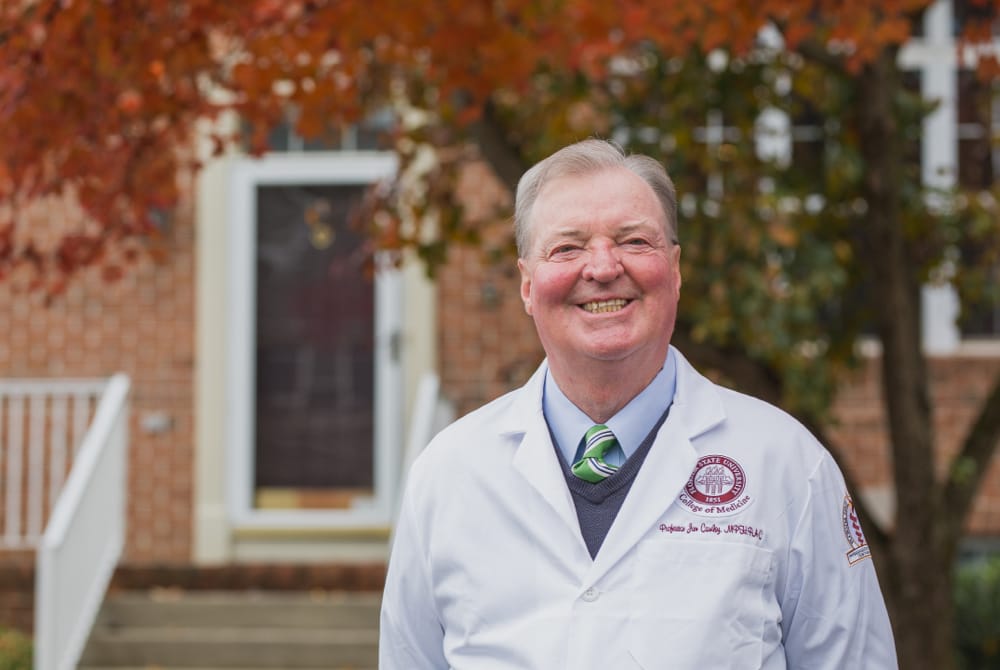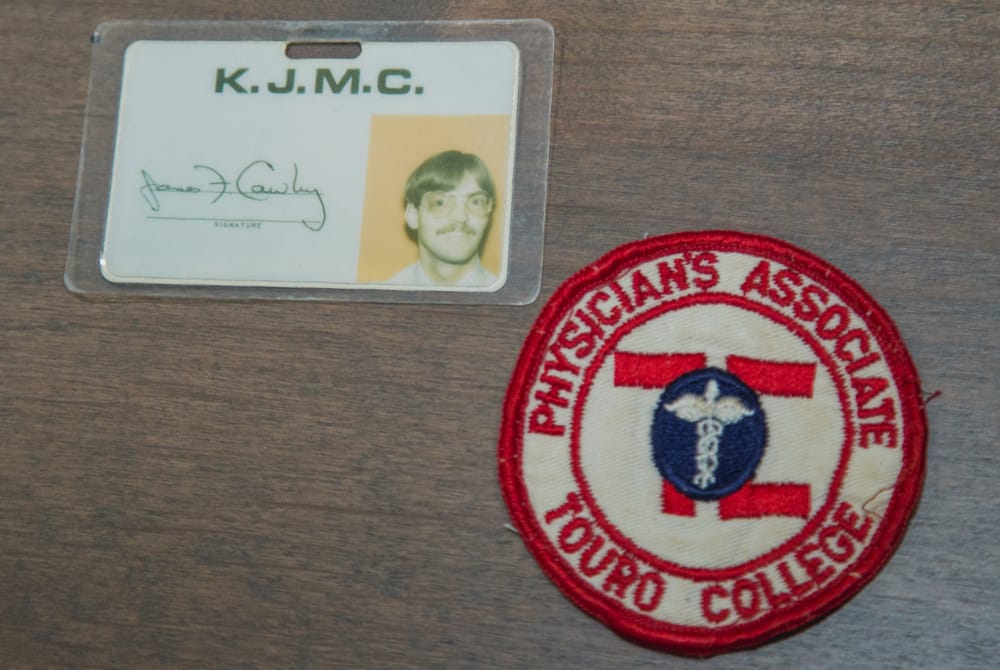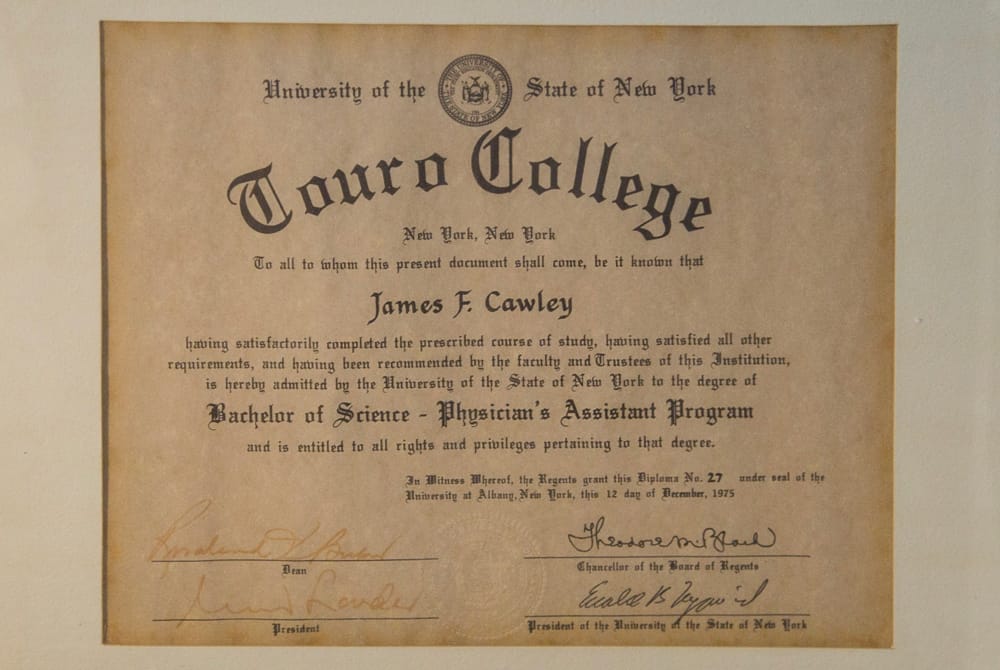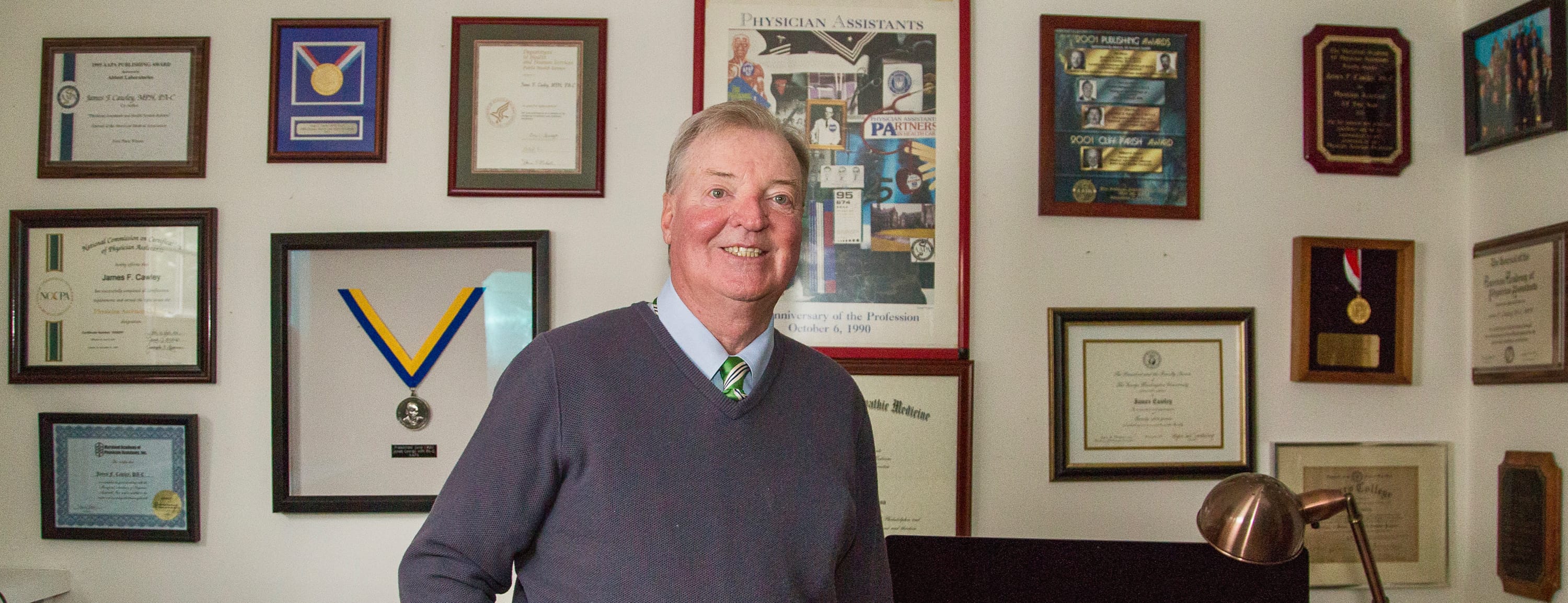A Touro Graduate Who Documented the Rise of the PA
PA James Cawley (’74) Authored Five Books and 130 Papers About Changing Field

With more than five books chronicling the rise of the physician assistant (PA) profession and more than 150 papers published in respected scientific journals, James Cawley is one of the leading historians of the PA profession. Cawley, who retired in 2018 after 38 years at The George Washington University, readily admits that his journey, which began as a member of Touro’s first class of physician assistants, was an unlikely one.
After completing his service in the US Army, Cawley planned to finish his political science degree but needed to wait a semester. He took a job as an orderly in a hospital and found himself interested in the medical field. Then a friendly resident told him about the PA profession and recommended Touro.
“I was a political science major, so I didn’t take any science classes,” recalled Cawley. “I was intrigued by the idea of the PA program. It was an opportunity to practice medicine with physicians, but the educational period was much shorter. It seemed as though there were advantages to that. Touro’s program was brand new, so I took a chance. In the end, I got a very good education.”
At the time, the Touro PA program were based out of a single townhouse in East Flatbush. Cawley lucked out and managed to rent an apartment next door. He recalled his experience in PA school fondly.
“We were treated like medical students,” explained Cawley who graduated in 1974. “We learned an awful lot of medicine in those days. It was a great experience.”
A Medical and Cultural Education

Describing himself as the “token Irish Catholic” from Central Pennsylvania, Cawley said that enrolling in a Jewish institution and meeting Orthodox Jews was eye-opening.
“It was quite a cultural education,” laughed Cawley. “It was fun. We learned about each other’s culture and what my classmates weren’t able to do on Friday nights. One of the things I learned about was the strong value Judaism places on education. Touro and my classmates wanted to learn from the best lecturers and work with the best physicians. We were exposed to a lot of really solid medical educators. Overall, I received a great medical education and a great cultural education.”
Cawley’s big break occurred while he was still a student. During a site accreditation for the PA program, Cawley was tasked with delivering a medical presentation to the visiting accreditors. One of the visitors, a pediatrician named Archie Golden, quizzed him afterwards and eventually offered him a job in Johns Hopkins University’s PA program after he graduated.
“Archie was the director of the program at Johns Hopkins, and they had me teaching 50 percent of the time and practicing the other 50 percent of the time,” explained Cawley. “It was a fairly high-powered academic program with lots of growth potential.”
Golden became Cawley’s mentor and encouraged him to enter Hopkins’ School of Public Health where he earned a master’s in public health.
“Archie developed me as a fledgling academic,” said Cawley. “He guided me through that process for the next eight years. That shaped my career trajectory.”

A Fledgling Academic’s Career Takes Off
When the Hopkins program closed in 1979, Cawley joined Yale University’s PA program. After three years he was offered a position at George Washington University’s PA program. Together with a fellow PA practitioner, Cawley began looking into the role of the PA inside the larger healthcare environment. Their first paper, published in the prestigious Annals of Internal Medicine journal in 1984, examined new and expanding roles for physician assistants in the medical workforce.
“Most people thought that physician assistants worked only in primary care,” stated Cawley. “What we observed was that physician assistants, more often than not, found roles in specialties and sub-specialties. We were describing the new patterns of PA utilizations.”
Cawley’s interest in research was fortuitous: the PA field was relatively new and poorly understood. He said his research was also motivated by his love of the field.
“It was born of our wanting to describe a PA and how they contribute to the medical system,” said Cawley. “We did a lot of examinations of PA’s quality of care, cost-effectiveness, and the economics of the PA profession. It was legitimate research that turned out to be very pro-PA and helped spread the word that PAs were competent and safe clinicians and a good value for society.”
Within the next few years, Cawley co-authored a critical text about the PA field, Physician Assistant in American Medicine, which was published in multiple editions.
“In some sense, all this was novel, and it was kind of easy to get things published,” remembered Cawley. “One thing fueled the next and my coauthors and I became fairly established as PA educators and researchers.”
For the next thirty years, Cawley and his co-authors churned out papers at a furious clip, exploring every aspect of the PA world. Cawley and his co-authors were published in prominent medical journals including Journal of Health Services and Research Policy, Health Affairs, Annals of Internal Medicine, JAMA, the Journal of the American Academy of Physician Assistants, Academic Medicine, and British Medical Journal. Cawley also co-founded GW’s joint PA/MPH program and served in roles ranging from the PA/MPH program director to Chair of the Department of Prevention and Community Health in the Milken Institute School of Public Health at GW. Throughout his lengthy career, Cawley received a dizzying number of accolades: In 2011 alone, he received the prestigious Eugene A. Stead Award of Achievement by the American Academy of Physician Assistants (AAPA); the Patron of the PA Profession Award bestowed by the University of Utah Physician Assistant Program; and was named Outstanding Maryland Physician Assistant of the Year by the Maryland Academy of Physician Assistants for the second time. He was also awarded an honorary Doctor of Humane Letters degree by the Philadelphia College of Osteopathic Medicine in 2013.
Cawley’s fifth book, Physician Assistants in a Changing Healthcare Environment, was published in 2017. Cawley retired in 2018 and is an emeritus professor at the university. His retirement is proving almost as busy as his career: he teaches online PA classes at Florida State University and conducts research as a visiting professor and scholar-in-residence in the Graduate School of the University of Maryland’s Physician Assistant Leadership and Learning Academy. As for taking the chance on a new PA program back in 1972, Cawley has no regrets. “It was the best decision I ever made,” he said.

The Future of the PA Profession: Q&A with Jim Cawley
Given Cawley’s foundational role in the physician assistant profession, we thought the 50th anniversary of his alma mater was a good chance to pick his brain about the PA field and some of the changes he’s witnessed during his long career.
Q: What do you think are the necessary qualities for a PA to have?
A: To be a strong PA you need to love people, love medicine and love practicing medicine. You must have integrity, be hard-working, and compassionate. Good communication skills also help.
Q: What are your thoughts about the current state of the PA profession and what do you predict for the future of the profession?
A: In general, the future is bright as evidenced by the high number of program applicants, strong job market, and ever-extending integration of PAs into the fabric of the health system. Significant changes will occur with the title change to physician associate and the slow march of optimal team practice (OTP). We need to get over our nurse-practitioner envy and stand tall ourselves. As PAs we should define our profession without attempting to be better than/competing with NPs. Also, as the reaction to our title change has shown, physicians are wary of us thinking that we are seeking independent practice. We should clearly stress that we are not.
Q: How has the field changed since it began?
A: The field has seen an astronomical growth in the number of female practitioners in what initially was a male-dominated field. Being a PA offers an avenue to practice clinical medicine while also maintaining a life outside of the medical world. If you were a female physician you had to go all-in. Being a PA allowed women the work-life balance and we see that in the numbers—72 percent of all PAs are women. Apart from this gender transition, a major part of PA evolution has been how PAs have been fully accepted by medicine, patients, and health systems. This acceptance is at an all-time high. PA cost effectiveness has been demonstrated conclusively as has quality of care, and low rates of malpractice actions. The original “experiment” with PAs in American medicine has been wildly successful.
Q: What surprised you the most from what you discovered through your research?
A: What surprised me the most was how the PA profession gave opportunities to many first, second, and third-career individuals to enter medical practice who otherwise would not have them. I've learned that PAs are remarkably flexible clinicians who can adapt rapidly to any and all clinical settings and specialties. I've learned that it does not take 10 years of training to become a caring and skilled primary care clinician.
Q: What advice would you give to a new PA?
A: Remain team-oriented, stay clinically strong and skilled, and support the profession through its organizations. I would also advise new PAs to take leadership opportunities when they find them, and like all health practitioners, care for the patient and remain curious about health and medical science.
Selected Publications – James F. Cawley, MPH, PA-C
Hooker, R.S., Cawley, J.F., Physician Assistants After Six Decades. American Journal of Managed Care 2021; 27:294-299.
Smith, N., Cawley, J.F., McCall, T. Examining the Gap: Compensation Disparities Between Male and Female Physician Assistants. Women’s Health Issues. 2017; 27-5;607–613.
Hooker, R.S., Cawley, J.F., Everett, C. Physician Assistants: Policy and Practice (4th Edition) Philadelphia, F.A. Davis, 2017, 308 pages.
Davis, A., Radix, S., Cawley, J.F. , Hooker, R.S., Walker, C. Access and Innovation in a Time of Rapid Change: PA Scope of Practice. Annals of Health Law 2015;23:286-336.
Cawley, J.F., Cawthon, E., Hooker, R.S. Origins of the Physician Assistant Movement in the United States. Journal of American Academy of Physician Assistants 2012;25:1-7.
Hooker, R.S., Cawley, J.F. Predictive Modeling of Physician Assistant Supply. Public Health Reports 2011, 126; 708-716.
Hooker, RS, Cawley, J.F., Leinweber, W. Physician Assistant Career Flexibility: A Primary Care Resource. Health Affairs, 2010, 30:888-898.
Mittman, DE, Cawley, JF, Fenn, W. Physician Assistants in the United States. British Medical Journal 2002;325:485-487
Hooker, R.S., Cawley, J.F. Physician Assistants in American Medicine. New York, Churchill Livingstone, 1997.
Jones, P.E., Cawley, J.F. Physician Assistants and Health System Reform. American Medical Association, 1994;271(16):1266-1272.
Cawley, J.F., Ott, J.E., DeAtley, C.A. The Future for Physician Assistants. Annals Internal Medicine, 1983; 98:993-997.